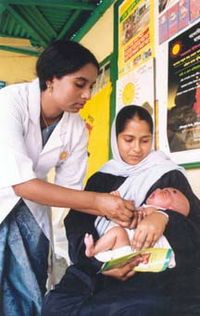Our website is made possible by displaying online advertisements to our visitors.
Please consider supporting us by disabling your ad blocker.
Preventive healthcare
The examples and perspective in this article may not represent a worldwide view of the subject. (March 2023) |
| Occupation | |
|---|---|
| Names |
|
Occupation type | Specialty |
Activity sectors | Medicine |
| Description | |
Education required |
|
Fields of employment | Hospitals, clinics |

Preventive healthcare, or prophylaxis, is the application of healthcare measures to prevent diseases.[1] Disease and disability are affected by environmental factors, genetic predisposition, disease agents, and lifestyle choices, and are dynamic processes that begin before individuals realize they are affected. Disease prevention relies on anticipatory actions that can be categorized as primal,[2][3] primary, secondary, and tertiary prevention.[1]
Each year, millions of people die of preventable causes. A 2004 study showed that about half of all deaths in the United States in 2000 were due to preventable behaviors and exposures.[4] Leading causes included cardiovascular disease, chronic respiratory disease, unintentional injuries, diabetes, and certain infectious diseases.[4] This same study estimates that 400,000 people die each year in the United States due to poor diet and a sedentary lifestyle.[4] According to estimates made by the World Health Organization (WHO), about 55 million people died worldwide in 2011, and two-thirds of these died from non-communicable diseases, including cancer, diabetes, and chronic cardiovascular and lung diseases.[5] This is an increase from the year 2000, during which 60% of deaths were attributed to these diseases.[5])
Preventive healthcare is especially important given the worldwide rise in the prevalence of chronic diseases and deaths from these diseases. There are many methods for prevention of disease. One of them is prevention of teenage smoking through information giving.[6][7][8][9] It is recommended that adults and children aim to visit their doctor for regular check-ups, even if they feel healthy, to perform disease screening, identify risk factors for disease, discuss tips for a healthy and balanced lifestyle, stay up to date with immunizations and boosters, and maintain a good relationship with a healthcare provider.[10] In pediatrics, some common examples of primary prevention are encouraging parents to turn down the temperature of their home water heater in order to avoid scalding burns, encouraging children to wear bicycle helmets, and suggesting that people use the air quality index (AQI) to check the level of pollution in the outside air before engaging in sporting activities. Some common disease screenings include checking for hypertension (high blood pressure), hyperglycemia (high blood sugar, a risk factor for diabetes mellitus), hypercholesterolemia (high blood cholesterol), screening for colon cancer, depression, HIV and other common types of sexually transmitted disease such as chlamydia, syphilis, and gonorrhea, mammography (to screen for breast cancer), colorectal cancer screening, a Pap test (to check for cervical cancer), and screening for osteoporosis. Genetic testing can also be performed to screen for mutations that cause genetic disorders or predisposition to certain diseases such as breast or ovarian cancer.[10] However, these measures are not affordable for every individual and the cost effectiveness of preventive healthcare is still a topic of debate.[11][12]
- ^ a b Hugh R. Leavell and E. Gurney Clark as "the science and art of preventing disease, prolonging life, and promoting physical and mental health and efficiency. Leavell, H. R., & Clark, E. G. (1979). Preventive Medicine for the Doctor in his Community (3rd ed.). Huntington, NY: Robert E. Krieger Publishing Company.
- ^ ""New parents" secure a lifelong well-being for their offspring by refusing to be victims of societal stress during its primal period". Primal Prevention.
- ^ "Primal Health Research Databank - Glossary". primalhealthresearch.com. Retrieved 2021-07-05.
- ^ a b c Mokdad AH, Marks JS, Stroup DF, Gerberding JL (March 2004). "Actual causes of death in the United States, 2000". JAMA. 291 (10): 1238–45. doi:10.1001/jama.291.10.1238. PMID 15010446.
- ^ a b "The top 10 causes of death". World Health Organization. 9 December 2020.
- ^ LeChelle Saunders, BSc: Smoking is Critical to Our Health. Be Smart, Don't Start
- ^ Isensee B, Hanewinkel R (November 2018). "[School-based tobacco prevention: the "Be Smart - Don't Start" program]". Bundesgesundheitsblatt - Gesundheitsforschung - Gesundheitsschutz. 61 (11): 1446–1452. doi:10.1007/s00103-018-2825-9. PMID 30276431.
- ^ Thrul J, Bühler A, Herth FJ (2014). "Prevention of teenage smoking through negative information giving, a cluster randomized controlled trial". Drugs: Education, Prevention and Policy. 21: 35–42. doi:10.3109/09687637.2013.798264. S2CID 73102654.
- ^ "'Be Smart, Don't Start' campaign launched to deter youths from smoking - The Malta Independent". www.independent.com.mt. Retrieved 2021-07-05.
- ^ a b "Medical Encyclopedia: MedlinePlus". medlineplus.gov. Retrieved 2021-07-05.
- ^ Cite error: The named reference
Healthaffairswas invoked but never defined (see the help page). - ^ Cite error: The named reference
Cohenwas invoked but never defined (see the help page).
Previous Page Next Page


